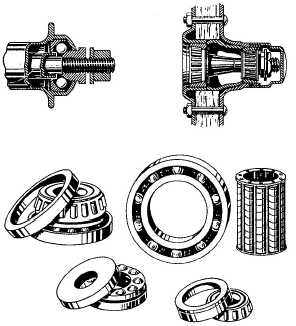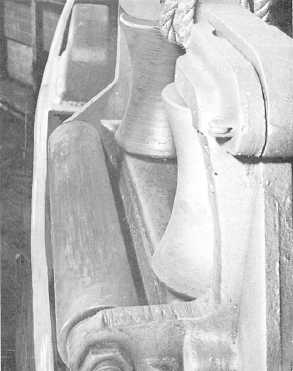one-forty-eighth of a foot. You gain force at the
expense of distance.
FRICTION
Suppose you are going to push a 400-pound crate
up a 12-foot plank; the upper end is 3 feet higher
than the lower end. You decide that a 100-pound
push will do the job. The height you will raise the
crate is one-fourth of the distance through which you
will exert your push. The theoretical mechanical
advantage is 4. Then you push on the crate, applying
100 pounds of force; but nothing happens! You’ve
forgotten about the friction between the surface of the
crate and the surface of the plank. This friction acts
as a resistance to the movement of the crate; you
must overcome this resistance to move the crate. In
fact, you might have to push as much as 150 pounds
to move it. You would use 50 pounds to overcome the
frictional resistance, and the remaining 100 pounds
would be the useful push that would move the crate
up the plank.
Friction is the resistance that one surface offers to
its movement over another surface. The amount of
friction depends upon the nature of the two surfaces
and the forces that hold them together.
In many instances fiction is useful to you. Friction
helps you hold back the crate from sliding down the
inclined ramp. The cinders you throw under the
wheels of your car when it’s slipping on an icy
pavement increase the friction. You wear rubber-
soled shoes in the gym to keep from slipping.
Locomotives carry a supply of sand to drop on the
tracks in front of the driving wheels to increase the
friction between the wheels and the track. Nails hold
structures together because of the friction between
the nails and the lumber.
You make friction work for you when you slow up
an object in motion, when you want traction, and
when you prevent motion from taking place. When
you want a machine to run smoothly and at high
efficiency, you eliminate as much friction as possible
by oiling and greasing bearings and honing and
smoothing rubbing surfaces.
Where you apply force to cause motion, friction
makes the actual mechanical advantage fall short of
the theoretical mechanical advantage. Because of
friction, you have to make a greater effort to
overcome the resistance that you want to move. If you
place a marble and a lump of sugar on a table and
give each an equal push, the marble will move
farther. That is because rolling friction is always less
than sliding friction. You take advantage of this fact
whenever you use ball bearings or roller bearings.
See figure 7-7.
Figure 7-7.—These reduce friction.
Figure 7-8.—It saves wear and tear.
The Navy takes advantage of that fact that rolling
friction is always less than sliding friction. Look at
figure 7-8. This roller chock cuts down the wear and
tear on lines and cables that are run through it. It
also reduces friction and reduces the load the winch
has to work against.
7-4




